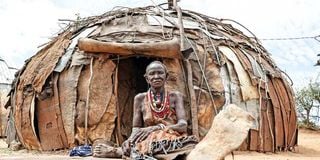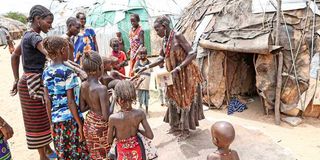
Nyawe Deyo sitting outside her Manyatta at Illiret, Marsabit County on April 20, 2024.
Nyawe Deyo, 76, who comes from the Dasanach tribe, a small community with slightly over 19,000 people living in Kenya, fashions her clothes from hide, which she also sleeps on. She once tried a mattress, but it made her itch so much, she never used it again...
Before the boom in modern clothing hit Kenya during pre-colonisation, many tribes and communities donned their finest animal skins, infused with plants and woven with other natural fibers.
While much of this attire is replicated every so often during cultural or national celebration days in Kenya, a woman from a small tribe living in Northern Kenya has made it an intentional effort to never wear modern clothing for the past 76 years.
After a journey that lasted just under two days, we arrive at her manyatta, nestled along the jagged and dusty path that makes up the road network in the village of Illeret, which sits just near the Ethiopian border, in Marsabit County.
Nyawe Deyo, 76, tells Nation.africa hat she already knows why we are here before our interview starts. Her smile, which is characterised by a wide gap between her two front teeth, and which is viewed as a sign of beauty, remains as constant as her energy as she greets us and our translator, who we will require because Nyawe only speaks in the vernacular language of the Dasanach tribe.
To ensure we are comfortable during the interview, she goes into her hut and pulls out a large mat made of goat skin. After we sit, she says she is ready to begin.

Nyawe Deyo giving children biscuits she received from well-wishers at Illiret, Marsabit County on April 20,2024.
“Since I was born, I have never worn a t-shirt or trousers like what you people are wearing. My body has never been in contact with any piece of modern clothing. I have always worn the traditional Dasanach tribe clothing which is made of animal skin,” Nyawe says.
Nyawe is wearing an aged slip skirt made out of goatskin that is the colour of cedar brown, and a gingerbread-coloured, off-shoulder dress- top, embellished with tiny colourful beads. Typically, the top half of her body would be uncovered, but when she first sees us, she is rather awkward and uncomfortable and pulls the top part up.
“What I am wearing on top is pure goat skin. Once a goat is slaughtered, I remove all of the meat until only the skin is left. I work on it until it is completely soft. My shoes are also made from cow skin. I then add accessories such as beads and my colourful necklaces so that it brings out the beauty of the piece,” Nyawe explains.
The Dasanach tribe is a small community with slightly over 19,000 people living in Kenya, even though some Dasanach people are also found in southern Ethiopia.
“The colourful necklaces I am wearing are the most modern thing on me, but the black ones are made from the tail of a dead giraffe, which was found some time ago. I do not think there is anything wrong with modern clothing, but I have just never liked it or wanted it on my body,” she says.
A background search on the Dasanach tribe shows photographs of how the traditional Dasanach woman used to dress back in the day, which mirrors exactly what Nyawe wears. The women from this community often wear their hair in short braids with a part in the middle.
“I have never been embarrassed about how I dress because I believe I am beautiful. People are often shocked and like to follow me around to touch my goatskin clothing. Even when white people sometimes come here, they really look at me. But I believe I am always beautiful in what I wear so why would I feel awkward or embarrassed?” she poses.
We offer Nyawe a t-shirt to see if she will be receptive to it.
“Because I do not want to hurt your feelings, I will take your gift, but I will not wear it. Maybe I can give it to one of my children,” Nyawe tells Lifestyle.
When Kenya witnessed its worst drought in 40 years in 2023, Nyawe says it halted life, as many know it in Illeret, in more ways than one.
“Before the long drought killed many cows and goats, I would send money to someone in Marsabit town to bring me cow or goat skin to make my dresses. I also sleep on hides. I once tried a mattress, but it made me itch so badly that I never used it again,” she says.
Dressing in the Dasanach way is something that Nyawe’s late mother taught her, which is among the reasons she holds on to her way of life so dearly.
“Young traditional Dasanach girls wear something similar to mine, but their attire is called “zahn,” while the one I am wearing, which is for older women is called “nyonkolos.” Amongst my peers, it is only me who has never dressed in any modern clothing. The rest converted,” Nyawe tells us.
The 76-year-old believes that her diet has played a major role in enabling her reach her 70s.
“I only eat traditional foods. I do not eat foods that have chemicals, even though they are as tasty as people say they may be. I mostly eat porridge, milk and beans, and I do not put salt in my food. I cook the food using only the fat extracted from the milk of a cow,” Nyawe says.
Does Nyawe believe that the culture of the Dasanach people is fading?
“Yes, because previously the Dasanach tribe was living the way I am living, but because of changes over time, they have stopped wearing animal skin attire. Many of them now wear clothes and even plastic shoes, which I will never wear,” she vows.
Due to her short frame, Nyawe is not easily the first person you would spot on entering the homestead that is filled with several huts, but she is the most authoritative, as the members of the community, both young and old, male or female, listen to her instructions keenly and keep their distance whenever she moves around, and will only approach her when she calls out to them.
True to her word, she hands the t-shirt that we brought her to one of the small children around her, who is only wearing a pair of orange trousers. The young boy excitedly runs off with it.
She watches him keenly.
“You see, even the young ones do not want to wear our animal skins,” she remarks before walking away









